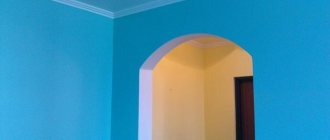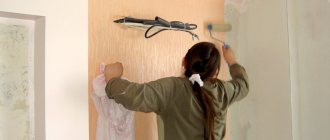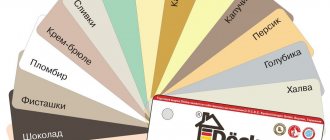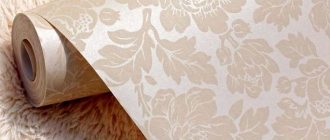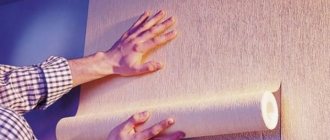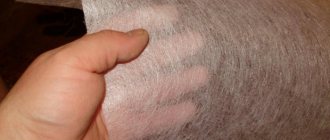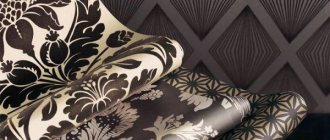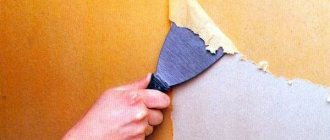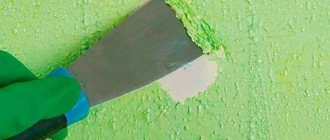Non-woven wallpaper is an ideal option for those who have never tried gluing this finishing material. Thanks to their properties and characteristics, the process is greatly simplified. After pasting, the room is transformed and is ready to delight its owner for decades.
Wallpaper has always been considered one of the most popular options for decorating a room. And if earlier these were the most budget options, today the level of quality of paintings has increased significantly. But how to properly glue non-woven wallpaper? The whole process can be divided into several stages. Depending on the size of the room and the skills of the worker, pasting can be completed in a few days.
Features of non-woven wallpaper
First you need to find out all the strengths of the canvases, as well as the features of gluing non-woven wallpaper. This is a rolled type of material, which consists of 70% cellulose fibers. 30% is polymer impregnation. The price of products depends on the type and quality. There are single-layer and multi-layer options, made entirely of non-woven fabric, or made on the basis of non-woven fabric with the addition of other material (paper, textiles, vinyl).
In appearance, the products are smooth and embossed. The first ones are easy to wash and can be painted. Other product features (wear resistance, sun protection, moisture protection, etc.) are indicated on the packaging. There is also information about the width, texture and correct joining of patterns.
Pasting non-woven wallpaper is a simple process, as this material has the following advantages:
- High density and strength of products.
- Non-woven wallpaper is quite elastic and can stretch a little.
- They are vapor permeable, the walls have the ability to breathe, and condensation will not collect.
- Protection from moisture, and washable options are practical when dirty.
- Easy to stick and remove.
- Ecological cleanliness.
- Low consumption of wallpaper glue, since it only needs to be applied to the surface of the wall.
- Long operational period.
There are much fewer disadvantages:
- High cost, but it is compensated by the best quality.
- The surface needs to be constantly cleaned with a damp cloth and vacuum cleaner.
- Non-woven wallpaper is susceptible to mechanical damage.
After analyzing all the pros and cons, you can choose non-woven wallpaper for yourself. Now let's look at how to glue products so that they last for decades.
Wallpapering uneven walls
The initial stage of gluing involves marking stripes on the wall. You can glue strips from a window or corner. The second option is more correct. Position the strip so that its edge touches the adjacent wall. This way the corner will be closed.
Note! Experienced craftsmen advise to provide a small supply of wallpaper, since there is a high probability of damage to several strips during the work process. For these purposes, add 1 roll to the calculations.
Next, you should apply glue to the wall and the strip itself and wait a while for it to dry a little. The second fragment should also overlap. Subsequent stripes are arranged end to end. This is a very important point.
It is not worth gluing all the fragments overlapping. This is due to the fact that then the joints of the individual stripes will be noticeable. If you have selected high-quality material, then there should be no problems in your work.
Interesting: Getting rid of mold on the walls in the apartment
Preparing tools
First you need to decide on the arsenal for the work. The good news is that the tools for gluing non-woven wallpaper are inexpensive and accessible:
- construction level (regular or better laser);
- 5m tape measure;
- a plastic spatula with a special soft edge, which can be used to ideally roll trellises;
- long-haired roller;
- a regular roller with a tray and a paint brush for priming walls;
- a brush that is convenient for smoothing glued trellises;
- assembly knife for cutting sheets;
- pencil;
- non-woven wallpaper glue;
- narrow metal spatula;
- two containers that are needed for water and glue;
- sponge.
But, before you hang non-woven wallpaper with your own hands, you need to buy the right amount of material, which would be enough for the upcoming amount of work.
Why non-woven wallpaper?
Non-woven wallpaper is environmentally friendly
Non-woven wallpaper is available in two types: consisting entirely of non-woven material and on a non-woven base with vinyl coating. They compare favorably with paper, vinyl, acrylic and other types due to their advantages:
- are produced on the basis of cel
- yulose fibers, environmentally friendly;
- have a beautiful textured surface that imitates plaster or has a pattern;
- most often produced for painting with acrylic or water-dispersion compositions;
- easy to clean, does not absorb odors;
- do not support combustion.
Even a beginner can hang such wallpaper well, but the technology for performing the work has its own nuances that need to be studied before starting pasting.
Calculating the number of rolls
All products have standard sizes. The sheet width can be 0.53, 0.7 and 1.06 m. It is most convenient to use meter-long non-woven wallpaper, since the work is done faster and there are fewer joints left. Rolls contain 10.05 m of products. It is worth taking into account the step of the drawing, if there is one. For example, the step may be 64 cm. Now let's start counting:
- First, the perimeter of the room is determined. It is equal to the sum of all the walls. For example: 6m + 5m + 6m + 5m = 22 m.
- Based on the perimeter, we find out the required number of canvases (strips), starting from the width: 22 m (perimeter) / 1.06 (width of the trellis) = 20.75 canvases.
- Next, we determine the height for one canvas, it will be equal to the height of the canvas + pattern pitch: 2.8 (ceiling height) + 0.64 (pattern pitch) = 3.44 m.
- The next step is to find out the number of whole canvases that are in one roll. To do this, the length of the roll is divided by our ceiling height with a pattern step: 10.05 (footage in 1 roll) / 3.44 (ceiling height with a pattern) = 2.92. Round up, we get 3 canvases (strips).
- Knowing the total number of panels required to hang wallpaper, as well as the number of panels in one roll, you can calculate the required number of rolls to purchase. It is enough to divide these values: 20.75 (strips per perimeter) / 3 (strips in one roll) = 6.91. Round up to 7 rolls per room with a perimeter of 22 m.
However, you need to take into account that the room has doors and windows. True, experts usually recommend buying material with a 10% margin. Therefore, 7 rolls will be enough, and those 10% of the reserve will be equal to the size of the windows and doors.
You will need less wallpaper without selecting a pattern, since there will be virtually no waste from it. In this case, you can skip the third point, and in the fourth, divide the footage on the roll by the actual height: 10.05/2.8 = 3.58 (4 strips). Then we divide the total number of strips into strips in one roll: 20.75/4 = 5.18 rolls.
Algorithm for gluing on walls with your own hands
It is important not only to carefully prepare for repairs, but also to carry them out correctly. Step-by-step algorithm for finishing work:
- A day before repair work, the room is ventilated, then the doors and windows must be tightly closed.
- Wall measurements are taken and markings are made.
- Wallpaper is cut into sheets of the required size, plus 8-10 cm for tolerance.
- The glue is loosening.
- Select the place from which pasting will begin. Experts recommend starting from the corner, making an indent of 4-5 mm.
- Apply glue to the base using a roller. The layer should be slightly wider than the trellis.
- Next you need to glue the first canvas.
- After this, you need to roll over the canvas on the wall, moving from top to bottom, from the middle of the glued wallpaper to the edges. If excess glue protrudes, it must be removed with a sponge.
- The next sheet is glued in the same way, but end-to-end. If gluing fails or the pattern does not match, the sheet can be removed and re-glued.
- Then, using a roller with a rubber tip, air is released and excess glue is removed. The joints are rolled.
Wallpaper is cut into sheets of the required size, plus 8-10 cm for tolerance.
Choosing glue
Even before gluing non-woven wallpaper, you need to choose the appropriate adhesive. How well and long the products will serve directly depends on the quality and adhesion properties of the adhesive. It is better not to spare money on its purchase.
The best option for gluing non-woven wallpaper is special substances based on dry modified starch. They need to be prepared immediately before gluing non-woven wallpaper. The substance is mixed until homogeneous.
There are a number of requirements for glue for such wallpaper:
- High level of adhesion to both canvas and wall.
- Thickness, which makes it easier to apply the composition thinly and evenly on the wall.
- After drying, it should not turn yellow or show any color.
- The substance should not react with coloring pigments if it is wallpaper to be painted.
The market provides many options for good adhesives. The best adhesive for non-woven wallpaper can be selected from this list:
- Quelyd “Special non-woven fabric”. Its peculiarity is in additives that protect the wall and trellises from the development of bacteria and fungi. The walls will not mold and deteriorate. And due to the fact that in its finished form it glides well, when gluing it is easy to adjust the wallpaper butt to each other. A good option for working with dense products for further coloring;
- Metylan "Ultra premium non-woven fabric". Contains starch and polymer additives. This ensures good adhesion to any surface. This includes drywall without prior puttying and cork. To prevent it from drying out quickly, it is better to make it more liquid than indicated on the package;
- KLEO Extra Non-woven is another option with antifungal additives. It is used for regular wallpaper and for non-woven wallpaper for further coloring. It is better not to glue white products with them, as yellow spots may appear from under them.
Other types of adhesive compositions are also commercially available. But the above are some of the best and most proven, and non-woven wallpaper is hung using them.
Glue selection
Choose compositions strictly for non-woven wallpaper
When choosing an adhesive, be sure to make sure that it is written on the pack that this adhesive composition is suitable for gluing walls with non-woven wallpaper.
Let us consider in the table the most common types of adhesives for non-woven wallpaper and their characteristics:
| № | Glue brand | Characteristics |
| 1 | Metylan | It is made on the basis of methylcellulose and contains additives that improve adhesion to the surface. Has antifungal protection. Resistant to temperature changes. The adhesive is slippery, so you can move the wallpaper if it is applied incorrectly. |
| 2 | Quelyd | Glides well, has antifungal protection, and is easy to apply to the surface. Has low consumption. |
| 3 | Kleo | It is produced on the basis of modified starch and includes antifungal additives. It is manufactured in three types: Optima, special and professional. The latter is suitable for pasting in hard-to-reach places. |
| 4 | PUFAS | It has high adhesion, is transparent after drying, and does not require special preparation of the walls. Available in 5 types, suitable for manual application and use in wallpaper-lubricating machines. |
When choosing a glue, you need to pay attention to the following indicators:
- density and structure of wallpaper;
- surface quality;
- glue consumption.
Before pasting, the surface of the walls must be leveled, all depressions and cracks must be eliminated, as air bubbles and peeling may form in them. It must be diluted strictly following the instructions.
Preparing the walls
Do I need to prime the walls before wallpapering? Yes, if this is not done, even the highest quality glue will not help improve adhesion. The peculiarity of non-woven wallpaper is that it can be glued to any surface: concrete wall, plaster and putty, plasterboard, pressed wood boards (OSB, plywood, fiberboard). However, before gluing non-woven wallpaper for painting, the walls are prepared according to the following scheme:
- Cleaning of previous finishes: wallpaper, plaster, whitewash or paint.
- Checking the evenness of the walls using a rule or level. If differences of more than 10 mm per 2 m of area, recesses and protrusions of more than 5 mm are found, then leveling of the walls is required. Regular putty will do for this. After drying, the surface is sanded with sandpaper.
- Next, the walls are cleaned of dust and dirt, stains, if any, are removed.
- The final stage of wall preparation is priming. The primer will help improve adhesion between the wall and non-woven wallpaper, strengthen the base, and also reduce glue consumption.
The primer will close the pores in the wall, so the wall will not absorb moisture from the adhesive so intensely. The primer is applied in two layers with breaks for drying. To work you need a roller and a brush. The entire surface is treated, even hard-to-reach places.
All further work can begin after the second layer of soil has completely dried. This completes the processing of the walls before gluing.
Surface preparation
Before gluing meter-long non-woven wallpaper with your own hands, you need to pay sufficient attention to preparing the base. This material can be glued to any surface (wooden, concrete, plastered), but only on a perfectly smooth wall is it possible to achieve an even coating.
To prepare the surface for gluing, it is necessary to carry out the following work:
- the old coating should be removed;
- cracks, pits, peeling - remove by leveling the surface with putty;
- It is advisable to carry out a general leveling of the wall using putty, and then smooth out the unevenness with sandpaper;
- The leveled surface is covered with soil.
In this way, the walls are sequentially prepared for pasting in the living rooms, kitchen and hallway.
Is it possible to glue it to old wallpaper?
Methods for gluing surfaces with roll materials vary. What is acceptable for paper products is unacceptable for non-woven material. Thus, gluing on old wallpaper is not recommended for non-woven products .
Usually, denser non-woven fabrics have a decent weight, which is why a weak base with paper may simply not withstand the load and fall off the wall. In addition, the darker colors of the old wallpaper, located under light wallpaper, will show through, changing the appearance of the material.
Markings on the wall
The peculiarity of non-woven wallpaper is its smooth and high-quality edge. Thanks to this, there is no need to glue them overlapping, only end-to-end. This option is better, since the joints will not be very noticeable; the joint will not even be visible. And thanks to the fact that we have meter-long non-woven wallpaper, the number of joints is reduced to a minimum. But first, it is important to make markings on the wall to simplify the task in the future.
It is recommended to start the entire process from the window of the room. Marking is reduced to drawing strictly vertical lines in increments of 1 m relative to each other. Particular attention should be paid to the first line, it is the starting line. The work uses a level and a pencil. Thanks to the markings, you can be sure that the strips of non-woven wallpaper will be glued perfectly evenly.
Pasting the ceiling
Finding a ceiling without cracks, holes or pores until it has undergone finishing is a rarity in our conditions.
However, you can deprive your ceiling of such problems yourself. And it will take a little - stick non-woven wallpaper on the ceiling.
They perfectly hide imperfections of the surface, including the ceiling. Non-woven fabric has such capabilities, first of all, due to its thickness, and then to the structure of the material. Due to this, gluing them is a pleasure.
Ceiling non-woven wallpaper does not stretch. It is also important that bubbles do not form when the glue gets wet. The canvas lays out perfectly and straightens over the surface.
The adhesive is applied to the ceiling. In this case, it is worth taking care of the cleanliness of the surface, which should be dry and clean. After this, the ceiling can be coated with a primer to improve the adhesion of the adhesive.
Pasting the ceiling with non-woven wallpaper is quite simple. There is no need to painstakingly adjust the panels end to end. But there is some peculiarity. Wallpaper sheets should be overlapped, and the joint line should be aligned by cutting off the excess along the line of the previous one. If you follow the technology correctly, you will get an even row of panels.
Then you need to give it time to dry. However, it must be remembered that fresh air can disrupt the process. This will upset the entire ensemble, and the separated areas will ultimately disappoint the repair. Therefore, windows and doors in the room should be closed.
When the wallpaper has dried, you can move on to the painting stage, if the appropriate wallpaper is selected. You need to decide on a color. An excellent option for the ceiling is pleasant and gentle colors. Sky blue, snow white or light peach can look great.
When choosing the color of the ceiling, you must not forget that it should be harmoniously combined with the color of the walls.
Water-based latex paint is suitable for painting. To apply it, you should use a soft regular roller. The paint is applied perpendicular to the window.
It is applied in two layers. This will help avoid any unpainted areas. If you decide to decorate the room with stucco, then they should be painted together with the non-woven ceiling wallpaper. To do this, you need to use a brush, not a roller. Particular attention should be paid to painting the connecting seams of the cornices.
You might be interested in modular PVC flooring.
Or an article on how to choose flooring depending on the room (kitchen, bedroom, bathroom, etc.).
Preparation of canvases
Pasting walls with non-woven wallpaper includes preparing it and cutting it into convenient strips. Experts recommend cutting blanks not just for one, but for all the walls in the room at once. The only difficulty may arise with the formation of the pattern. If it is not there, everything will be much easier. From our example, the ceiling height is 2.8 m. Therefore, it is enough to take a tape measure, measure this height and cut a strip of wallpaper.
Advice! It's best to make sure the ceiling height is the same all around.
If the picture is present, you need to make a selection. The fitting size is indicated on the product packaging. We considered the option with 64 cm. Having cut off one strip, you need to attach it to another, checking whether the pattern matches. When cutting non-woven wallpaper one by one, put them aside in the same order so as not to mix them up.
Since wallpaper can be damaged or dirty when cutting, it is important to prepare your work area. Ideally, lay a clean polyethylene sheet on the floor or clean and wash the floor. After which the roll is rolled out face down. The required height is measured from it and a notch is made with a mounting knife.
Important! Experts recommend making a margin of 5 mm on each side. The remainder will then be cut off with a mounting knife, and the joint will be formed perfectly even.
The canvas is bent along this notch, its evenness is controlled. All that remains is to cut the non-woven wallpaper along the line with a mounting knife. Further strips are cut in a similar order.
Preparing wallpaper
When purchasing wallpaper in a store, it is recommended to pay attention to the release date and article number; if wallpaper with the same pattern was produced in different batches, there may be a slight difference in tone.
To prepare the working strip, it is necessary to measure the distance from the floor to the ceiling and increase it by 3-5 cm for correction margin. If it is necessary to adjust the pattern, you can try on the second strip, placing it next to the first on the floor, and cut it taking into account the height adjustment.
The sheet should be cut with a sharp knife or spatula, after first bending the sheet, aligning the side surfaces of the bottom and overlay sheet.
Quantity calculation
To calculate how many rolls to buy, you should find the total surface area that you plan to cover and divide it by the area of one roll, increasing to a whole number.
If the wallpaper is plain and does not require adjustment to the pattern, the value found will be correct; if the wallpaper needs to be adjusted, it is recommended to increase the calculated value by 5% to purchase a safety stock.
Preparation of glue
We know what glue to use to glue our products. But how to prepare the substance? This must be done immediately before gluing. Usually the packaging contains simple instructions that will help you achieve the best results. However, it may be different for each manufacturer.
How to dilute wallpaper glue? Preparation technology: water is poured into a bucket (the amount is indicated in the instructions), dry powder is gradually poured into it. In this case, you need to thoroughly mix all the contents. No lumps should form in the composition. When all the powder is dissolved in water, you need to give the composition time to infuse. After a while, the glue is mixed again, and if lumps appear, they are removed. Everything is ready to go.
Difficulty adhering to uneven surfaces
When you need to hide uneven walls with wallpaper , pitfalls may pop up here. You can use the leveling that is done before pasting. But if you do not resort to this procedure, then 3 main difficulties arise:
- You need to glue wallpaper on crooked corners, where the amount of curvature will be enormous.
- The relief is visible even after finishing.
- There are spaces under the canvas that will later form bulges.
Non-woven wallpaper gluing technology
Now we have come close to the question of how to properly glue non-woven wallpaper. The entire preparatory stage has been completed, only a small matter remains. Below are step-by-step instructions:
- Be sure to read the manufacturer's instructions. It indicates some of the subtleties of working with this particular type of wallpaper, for example, is it possible to glue non-woven wallpaper onto old non-woven wallpaper or where exactly to apply the glue: only on the wall or on the wall and the canvases themselves.
- Using a brush or roller, glue is applied to the rolled out fabric (if required by the instructions). Glue is applied to the wall. In order for the edges to adhere well to the surface, it is recommended to coat not exactly 1.06 m, but a little with a margin.
- All that remains is to paste the non-woven wallpaper onto the wall. The strip is fixed at the top according to the markings, after which it gradually straightens down. If necessary, the edge is adjusted to the markings by shifting the strip. This will allow you to paste the wallpaper perfectly evenly.
- Now air and excess glue are expelled from under the trellis. This can be done with a roller or a soft plastic spatula. A roller is needed for textured wallpaper with a pattern, while it is convenient to smooth out smooth wallpaper with a spatula. Remains of glue are removed immediately with a sponge or wet cloth. Since we have a margin of 10 mm, the remainder, if any, is cut off with a mounting knife. A wide spatula can be used as a guide.
- The further technology for gluing wallpaper is similar. The wall is coated, the canvas is straightened and fixed in place butt to the first strip. It is leveled, the air is expelled from it, and the remains are cut off. The work is carried out until all the walls are glued.
All you have to do is wait for it to dry and the work is complete. During this time, windows should not be opened to avoid drafts. Otherwise, the products may fall off the wall and the work will be done in vain. Now everyone knows how to properly glue non-woven wallpaper.
Pasting instructions
For non-professional finishers who want to decide how to properly glue non-woven wallpaper, it is recommended to use the following step-by-step algorithm:
- They start painting the room from the window. To glue the first sheet, which will serve as a vertical guide for all subsequent sheets, you need to make markings. To draw a vertical line at a distance of 1000 mm from the corner, it is advisable to use a laser level, which will allow you to maintain a strict perpendicular to the floor.
- The prepared adhesive solution is applied with a roller to the wall, treating the surface required for placing the canvas, with a small allowance towards the larger side.
- The canvas is glued to the wall, focusing on the vertical mark. If everything is done correctly, subsequent sheets will fit together perfectly.
- Next, you can apply glue to the wall for two or three stripes at once.
- Each canvas must be carefully smoothed with a rubber roller or a plastic rule, getting rid of bubbles, removing excess glue and adjusting the joints.
- When marking the wallpaper along the length, leave a small allowance to align the top edge. The edge of the canvas at the junction with the ceiling or ceiling plinth is carefully folded and cut with a knife, using a wide spatula as a guide base.
- The lower edge is cut with scissors or a knife, leaving a small distance to the floor, which will be covered with a fillet or plinth.
- If it is necessary to adjust the pattern, marking the wallpaper is done with a large allowance in height.
- It is advisable to prevent glue from getting on the surface of the canvas, since low-quality and cheap solutions can leave yellowish stains.
- It is better to paste corners using the overlapping technology.
How to tape corners correctly
It is not easy to do high-quality gluing of non-woven wallpaper in a corner without some experience. The success of this procedure depends on the preliminary preparation of the base.
If the corner has been leveled before pasting the room, there will be no special problems when gluing wallpaper end-to-end or when covering the corner with a whole canvas in this place. As a corner leveler, you can use plastic corners, which are installed at the time of preparing the base and then plastered.
It is more difficult to make an even angle on a poorly prepared base. In this case, it is recommended to overlap the corner.
First, glue one strip overlapping the corner by two to three centimeters, then glue the strip along the second wall, also with an overlap, after which you need to make a vertical cut, pressing a ruler or a long spatula close to the corner. Excess strips are removed and the seam is smooth.
What to do if the wallpaper bubbles
How to glue non-woven wallpaper with your own hands in such a way as to avoid the appearance of bubbles? A common mistake novice finishers make is violating the recommended dosage of glue. It is the incorrect preparation of the adhesive composition, as well as high (more than 25°C) room temperature and draft that cause the wallpaper to peel off from the wall.
It is also important when gluing the canvases to carefully straighten and squeeze out air pockets and avoid crooked joints. Compliance with these rules will help you avoid annoying defects in your work.
When can you open windows after pasting?
To avoid problems with the quality of pasting, you need to understand how long you can’t ventilate the room after finishing work. It takes at least a day for the adhesive and material to adhere securely, but for some types of wallpaper it may take up to 72 hours.
Premature ventilation will lead to uneven drying, which will lead to non-woven wallpaper peeling off, strip joints to diverge and the formation of uneven edges near the ceiling and in the corners.
Covering the doorway.
At what temperature to glue wallpaper
Modern materials retain their quality characteristics at temperatures from 10 to 25°C , which allows work to be carried out both in summer and in winter, when central heating performs the function of maintaining the optimal temperature in the apartment.
It is not recommended to paste wallpaper at lower or higher temperatures, since the work production technology will be disrupted, and the quality of gluing will not be guaranteed.
How long does it take for wallpaper to dry?
How long it takes non-woven wallpaper to dry after gluing can be read in the instructions on the glue packaging. Typically this period ranges from 12 to 20 hours, but experienced finishers recommend keeping the room closed for 24 hours . Only after this period is it permissible to ventilate the room.
When you touch it with your palm, you can determine the condition of the wallpaper. If humidity is felt, ventilation cannot be carried out; if the surface is dry and a day has passed since pasting, you can proceed to the next work.
How to glue wallpaper in corners
I would like to pay special attention to working with corners. There are several ways to glue non-woven wallpaper in the corners. The simplest of them is this: a strip of wallpaper should overlap the corner by 5–7 cm. The wallpaper in the corner is fixed with an overlap. Then the remains are cut off. To prevent a gap from forming, the two layers are pressed well using a spatula, and a perfectly straight vertical line is drawn in the corner using a mounting knife. The cut strips are removed and the edges are glued again.
Door and window openings are not as difficult to process as they seem. Especially if selection of a pattern is not required. In this case, the wall is glued on one and the other side of the frame. Only the untreated area above the door and above/under the windows is left. These areas will be covered later, after measurements have been taken. This is how you can glue corners with non-woven wallpaper and other hard-to-reach places.
Which wallpaper glue is best to choose for non-woven wallpaper?
Paper is used as the basis for wallpaper production, which allows the use of starch-containing compositions. You can glue using PVA glue or specialized mixtures. If they contain polymer components, then such wallpaper can be glued to drywall or cork without puttying. Mixtures are now being sold that include antibacterial additives that prevent mold and mildew from appearing.
This problem is solved with a primer. Before gluing, you need to take into account the thickness, size and weight of the strips. If we are talking about massive non-woven wallpaper, then a thick (viscous) solution is used when gluing. The lungs can be glued to liquid. If the wall surface has unputtyed shells, glue that has increased thickness is used. The preparation recipe is indicated in the instructions for use.
The wallpaper is bubbling, what should I do?
In this case, action must be taken immediately, since this defect is unacceptable and can affect both the appearance and further operation. Bubbles usually form due to adhesive waste. It is important to follow the instructions and apply it as much as needed according to the instructions. Then there will be no such problems under normal conditions. If this happened, perhaps the work was carried out in a draft, or the temperature in the room during work reached 24 degrees or more.
When wrinkles and folds form (they do not indicate careless smoothing), all that remains is to carefully peel off the strip, straighten it and glue it back. However, if non-woven products were glued on top of others, it will be impossible to tear them off without damage!
We recommend that you read: What to do if the wallpaper comes off.
What tools will you need?
You should prepare in advance. You will need equipment and tools. Before you start working with non-woven materials, you need to think about what kind of glue to use and what you will need for this. The process cannot complete successfully without:
- wide brushes or rollers for applying adhesive;
- wallpaper knives and a wide spatula for cutting the ends of the strips;
- special equipment (electronic levels, plumb lines or levels);
- containers for preparing glue;
- clean dry rags for smoothing the surface of the wallpaper;
- stationery scissors;
- narrow rubber rollers for rolling seams (joints);
- pencils or ballpoint pens for marking.
All of the above must be available. The list does not indicate the tools necessary for the preparatory work.
How long does non-woven wallpaper take to dry?
How long does non-woven wallpaper take to dry after gluing? The peculiarity of non-woven fabric is its quality and reliability. But it will be like this if you follow all the recommendations. So, drying time is about 24 hours. During this time, the formation of drafts, as well as a strong increase in temperature, should not be allowed. To check for dryness, just touch the canvas and feel how dry it is. In this case, the drying time does not depend on the thickness of the products.
We looked at how to properly hang non-woven wallpaper on a wall. Even a beginner can cope with this task, especially if there are such clear and detailed instructions. The main thing is to follow all the rules and subtleties, be careful and not rush. Having the tools for wallpapering, as well as the material itself, you can process the room within a day and a day later enjoy the luxurious renovation of your apartment. Fast, practical and cheap when compared with other types of finishing.
